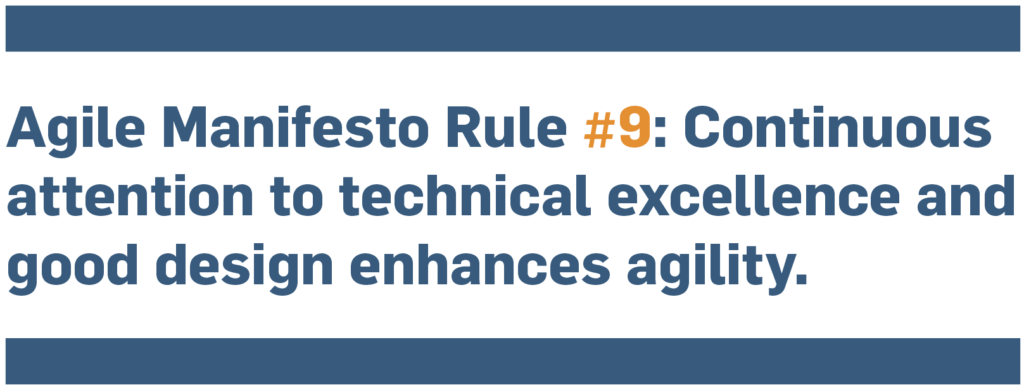This article is the 11th part of a 12-part series featuring snippets from my book, The Agile Secret.
- 1. Living in the VUCA World
- 2. The Freelance Revolution
- 3. The Digital Revolution
- 4. The Birth of Agile
- 5. Get It Done
- 6. Shipping Is The Metric
- 7. I Ride My Bike Tuesdays
- 8. Even Better If
- 9. Change It? Of Course?
- 10. Let’s Meet, Briefly
How can leadership enhance technical excellence and good design? How can we encourage a continuous focus on those things? Two types of investment are required. The first is an investment in the training, growth and learning of individuals and teams. The second is a commitment by the leader to giving specific, detailed – and potentially unpopular – feedback.

Investment one: Training

Acquiring technical excellence takes practice, training and experience. My friend Pete is a very gifted musician. When his fingers hit the ivories and he starts to sing it is a wonderful thing. Often, he is not doing that much. A few chords. A simple melody. His excellence allows him to achieve a great deal very simply. Matteo is a great graphic designer. He has studied for many years. His layouts are magic. Karen is a powerhouse and ninja in growing businesses. Ninety minutes of Karen’s simple advice can result in tens, even hundreds of thousands of pounds of business revenue. Karen, Matteo and Pete have invested in technical excellence. In doing so, they have worked out how to achieve great results very simply.
What a gift! Leaders of teams should pursue and develop such individuals if we are to benefit from the awesome productivity of an agile team.
They say, “A camel is a horse designed by committee.” Great leaders allow technical experts to lead design work on a project, knowing that the vision of one great person is preferable to the compromise that is cobbled together from the wish list of a wide variety of uncommitted “stakeholders”. The term, “intelligent design” has been hijacked by religious fundamentalists. Intelligent design in its purest sense makes every job from there on in easier.
Investment two: Feedback
Technical excellence and good design are also achieved by robust reviews and specific feedback. When working with leaders or facilitators on a training programme, I love helping them with the nitty gritty of the detail. Ditto, when designing a programme. It’s a great joy to provide sophisticated improvement points. True mastery and great design comes iteratively. It comes by day-to-day working on small details. Great team leaders will make and take the time to do this; patiently, carefully, specifically.

Sometimes, for leaders, this is tough. It means providing cutting feedback in a sensitive way. Or screwing up plans and filing them in the trash. It requires iteration. Patience. Often it requires sleeping on things and coming back fresh in the morning. It can require retreat from blind alleys when much has been invested.
But isn’t saying, “We’ve got it wrong”, part of what leadership is? Isn’t speaking truth to power, making unpopular decisions, insisting on the highest standard of quality – isn’t that what leadership is?

Steve Jobs was apparently “difficult to work for”. Apple was the first company to reach a $1 trillion valuation. Steve knew something about speaking out with courage when something needed to be said. So often we want to be popular, non-confronting, accepted. Yet it is only by challenging ourselves that we can do something aesthetically beautiful.
Download The Agile Secret on Amazon Kindle here.
Next Week: ‘Sort It Yourself Please’
